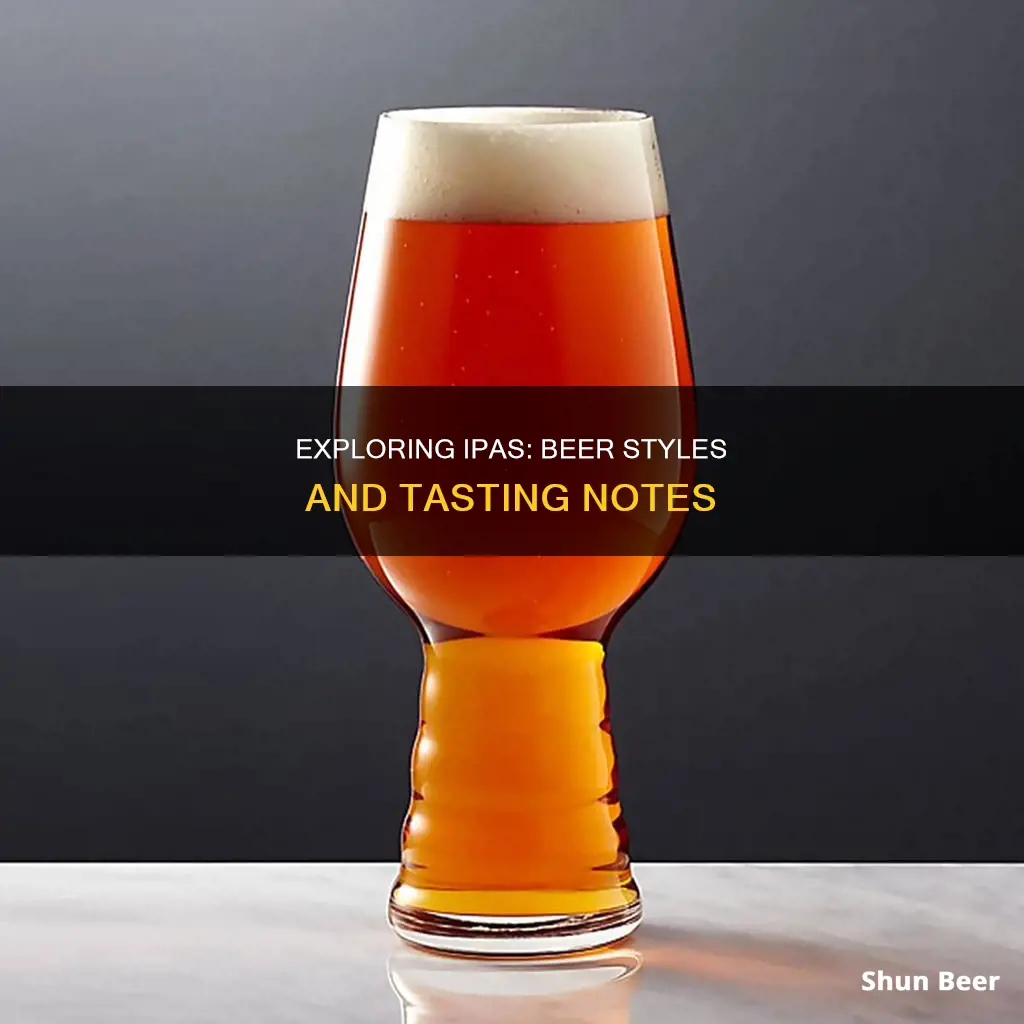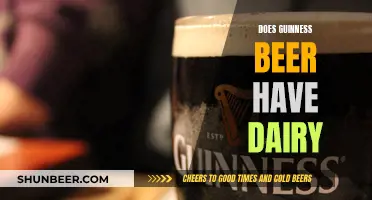
India Pale Ale, or IPA, is a hoppy beer style within the broader category of pale ale. The IPA was invented in Britain, where sailors added extra hops as a preservative to keep the beer intact on long voyages to India. Nowadays, IPAs come in a range of styles, with different alcohol by volume (ABV) percentages, and are one of the most popular beer styles in the UK and the US.
| Characteristics | Values |
|---|---|
| Full form | Indian Pale Ale or India Pale Ale |
| Origin | British colonial times |
| ABV | 5-7% |
| Taste | Hoppy, fruity, crisp, bitter |
| Types | West Coast IPA, New England IPA, Session IPA, British IPA, Double IPA, Imperial IPA, Triple IPA, Black IPA, Red IPA, East Coast IPA, American IPA, etc. |
| IBUs | 50 |
What You'll Learn
- Session IPAs are less alcoholic, usually under 5% ABV, and can be drunk repeatedly
- Double/Imperial IPAs have a higher hop concentration and ABV (usually over 7%)
- Dry-hopped IPAs are steeped in hops during fermentation, creating a strong aroma
- New England IPAs are unfiltered, hazy, and have low bitterness
- British IPAs are very hoppy and one-noted, and less popular today

Session IPAs are less alcoholic, usually under 5% ABV, and can be drunk repeatedly
Session IPAs are a sub-style of the IPA, which stands for India Pale Ale. IPAs are hoppy beers that originated in Britain and were exported to India in the 18th century. Early IPAs were slightly higher in alcohol content than other beers, but they were heavily hopped to survive long voyages.
Today, IPAs come in a range of styles, and while some are bitter, others explore the world of fruity flavours that can be derived from hops. Session IPAs are less alcoholic than other IPAs, typically containing less than 5% ABV, although historically they were 4% ABV or lower. This lower alcohol content means that session IPAs have a thinner body and can be drunk repeatedly without overwhelming the drinker.
Session IPAs deliver the same hoppy characteristics that people want from an IPA, but with a softer edge. They are often described as having a fruity, piney, or citrusy character, with a crisp, clean, and bitter finish. Session IPAs can be challenging to brew, as it is easy to end up with a watered-down or acidic beer. However, when done right, they are refreshing and highly drinkable.
Some popular examples of session IPAs include Founders Brewing Co.'s All Day IPA, Pipeworks Brewing Company's Lil Citra, and Oskar Blues Brewery's One-y 100 Calorie Hazy IPA.
Guinness Beer's Carb Content: A Detailed Breakdown
You may want to see also

Double/Imperial IPAs have a higher hop concentration and ABV (usually over 7%)
Double or Imperial IPAs are a stronger, hoppier version of the standard IPA. They have a higher ABV, more IBUs, and a slightly darker body. Double IPAs use more malted grains in the recipe to achieve a higher alcohol content, typically over 7%. The term "double" refers to the increased amount of ingredients used, particularly hops, resulting in a beer that is both higher in alcohol and richer in hop character.
Double IPAs are characterised by a strong hop profile with a wide range of flavours and aromas, from citrusy and floral to earthy and resinous notes. They are often favoured over standard IPAs due to their potent bitterness. While standard IPAs have IBUs ranging from 50-70, double IPAs offer a more intense bitterness, ranging from 65-100 IBUs.
The higher alcohol content in Double IPAs is a result of the increased use of grains in the brewing process. More hops are needed to balance out the malt and alcohol flavours, resulting in a beer that is both hoppier and more bitter. The recipe and ingredients for Double IPAs include a larger amount of hops, grains, and malt, creating a bolder and more intense version of the standard IPA.
The modern sub-styles of Double IPAs include the American Double IPA and the Juicy, Hazy New England style IPA. The American-style IPA, often referred to as a Double IPA, utilises American-variety hops with notes of citrus and pine, while the Juicy or Hazy (New England) style offers a bigger version of the Juicy and Hazy IPAs, with a robust flavour, hazy body, and a full mouthfeel.
Guinness Beer: Available in India?
You may want to see also

Dry-hopped IPAs are steeped in hops during fermentation, creating a strong aroma
India Pale Ale, or IPA, is a hoppy beer style within the broader category of pale ale. The term IPA is now used to refer to a wide range of beers, with the modern approach focusing on fruity flavours rather than bitterness.
Dry-hopped IPAs are created by steeping hops in the beer during fermentation, instead of adding them while the liquid is boiling. This process creates an extremely strong aroma, enhancing the fruity, piney, or candy-sweet notes of the hops. It makes the beer smell better without adding any bitterness.
During fermentation, yeast consumes the available oxygen, so dry hopping in this way can prevent the beer from becoming oxidised. However, this technique can be challenging due to the carbon dioxide created by fermentation, which can strip away the desired volatile compounds.
Most dry hopping occurs during secondary fermentation, but some brewers add hops during the active phase of primary fermentation. This results in a beer that differs not only in aroma but also in appearance and flavour.
The term "double dry-hopped" is often used by brewers, but it has no real definition. It could refer to using twice the amount of hops or adding a fresh batch of hops halfway through the process.
Dry hopping allows brewers to extract surprisingly different aromas, flavours, and appearances from their beers. This technique can be used to create a strong aroma in IPAs without adding bitterness.
The Evolution of Guinness Beer: A Historical Perspective
You may want to see also

New England IPAs are unfiltered, hazy, and have low bitterness
New England IPAs (NEIPAs) are a style of American IPA that is unfiltered, hazy, and has low bitterness. The style is characterised by an intense, tropical fruit-centric hop aroma and flavour, with a fuller body, smoother flavour, and less perceived bitterness than typical IPAs. This is achieved through a combination of brewing techniques, including the use of specific yeast strains, the timing of hop additions, and adjustments to the water chemistry.
The New England IPA is a relatively new style that originated in Vermont, in the New England region of the northeastern United States. It gained popularity in the US around 2011 and has since become one of the most sought-after IPA styles. The style is believed to have started with an IPA called the Heady Topper, brewed by The Alchemist brewery. Brewer John Kimmich experimented with an IPA recipe, choosing not to filter or pasteurise the beer, which are common methods used to extend a beer's shelf life. This resulted in a thicker IPA with microscopic compounds, enzymes, and cultures that added both flavour and aroma.
The haziness in NEIPAs is a result of various techniques employed by brewers to enhance aromas, create a smooth and creamy mouthfeel, and reduce the harsh bitterness associated with conventional IPAs. This includes using certain yeast strains that leave fruity esters and suspended matter in the beer, contributing to the haze. Additionally, hops are often added late in the boil, amplifying the aroma while extracting fewer alpha acids that provide bitterness.
NEIPAs are also known for their unique appearance, resembling orange juice with their opaque haze and golden yellow colour. They have a dense, creamy, cloud-like head with persistent carbonation bubbles rising to the top. The intense fruit-forward aromatics and flavours of NEIPAs are another defining characteristic, with notes of passionfruit, guava, papaya, mango, and pineapple. While the bitter flavours are often secondary, providing a more moderate bitterness that floats cleanly through the palate.
Overall, New England IPAs offer a distinct experience with their unfiltered, hazy appearance, fruity aromas and flavours, and low bitterness compared to other IPA styles. They have gained widespread popularity and continue to be a favourite among craft beer enthusiasts.
IPAs: Stronger Than Regular Beer?
You may want to see also

British IPAs are very hoppy and one-noted, and less popular today
India Pale Ale (IPA) is a hoppy beer style within the broader category of pale ale. It was originally an export beer shipped to India, which was under the control of the British East India Company until 1858.
The early IPAs were only slightly higher in alcohol than other beers brewed at the time. However, they were heavily hopped and formulated to survive long voyages by sea. The increased alcohol and hop content acted as preservatives, and IPAs became known for these qualities.
British IPAs are characterised by their maltiness, bitterness, and one-dimensional flavour profile. They are not the most popular style today, but they hold historical significance in the world of beer.
The English-style IPA is a stronger version of a pale ale, with a hearty helping of English hop character (earthy, floral) and increased alcohol content. English yeast lends a fruity character to the flavour and aroma, creating a contrast to the earthy English hop additions.
Over time, taxation has caused the English IPA to assume a lower alcohol content. With less malt required, there is less need for a strong hop presence, which could easily put the brew out of balance. As a result, modern British IPAs are less hoppy than their predecessors, and their popularity has waned compared to other IPA styles.
Today, the US-influenced IPA is one of the most popular beer styles in the UK. The traditional IPA style has evolved and gained inspiration from American hops, resulting in a boom in popularity worldwide.
Guinness Beer's pH Mystery: Is It Acidic or Not?
You may want to see also
Frequently asked questions
IPA stands for Indian Pale Ale or India Pale Ale. It is a hoppy beer style within the broader category of pale ale.
An IPA is hoppier and bolder than a pale ale. If a pale ale is tabasco sauce, an IPA is a habanero hot sauce.
Some popular IPAs are:
- Brewdog's Punk IPA
- Swannay's Muckle IPA
- Bass
- Whitbread's draught IPA
- Greene King IPA
- Charles Wells Eagle IPA
- Worthington's White Shield







